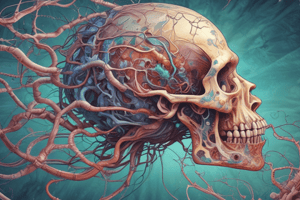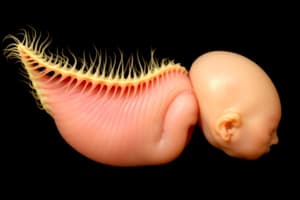Podcast
Questions and Answers
What is the most common type of Down Syndrome?
What is the most common type of Down Syndrome?
- Trisomy 21 Down Syndrome (correct)
- Translocation Down Syndrome
- Robertsonian Down Syndrome
- Mosaic Down Syndrome
Individuals with Down Syndrome cannot lead healthy lives.
Individuals with Down Syndrome cannot lead healthy lives.
False (B)
What is the chromosome count in individuals with Down Syndrome?
What is the chromosome count in individuals with Down Syndrome?
47 chromosomes
Down Syndrome is caused by an extra copy of chromosome ___
Down Syndrome is caused by an extra copy of chromosome ___
Match the type of Down Syndrome with its description:
Match the type of Down Syndrome with its description:
What is the most severe form of Spina Bifida?
What is the most severe form of Spina Bifida?
Spina Bifida Occulta is the mildest form of Spina Bifida and usually presents with symptoms at birth.
Spina Bifida Occulta is the mildest form of Spina Bifida and usually presents with symptoms at birth.
What imaging technique is typically used for prenatal diagnosis of Spina Bifida when elevated alphafetoprotein is detected?
What imaging technique is typically used for prenatal diagnosis of Spina Bifida when elevated alphafetoprotein is detected?
The risk of developing Spina Bifida can be reduced by adequate ______ intake during pregnancy.
The risk of developing Spina Bifida can be reduced by adequate ______ intake during pregnancy.
Match the following conditions with their effects:
Match the following conditions with their effects:
Which of the following can be a treatment option for managing hydrocephalus associated with Spina Bifida?
Which of the following can be a treatment option for managing hydrocephalus associated with Spina Bifida?
The incidence of Spina Bifida is approximately 3-4 per 10,000 live births in developed countries.
The incidence of Spina Bifida is approximately 3-4 per 10,000 live births in developed countries.
Name one prenatal intervention that can be performed before 26 weeks of pregnancy to address Spina Bifida.
Name one prenatal intervention that can be performed before 26 weeks of pregnancy to address Spina Bifida.
Which type of amputation is primarily due to traumatic events?
Which type of amputation is primarily due to traumatic events?
Cerebral Palsy is a progressive neurological disorder.
Cerebral Palsy is a progressive neurological disorder.
What is the most common type of amputation?
What is the most common type of amputation?
The primary concern of rehabilitation after amputation includes physical and _________ support.
The primary concern of rehabilitation after amputation includes physical and _________ support.
Which of the following is a psychological effect associated with amputation?
Which of the following is a psychological effect associated with amputation?
Match the types of Cerebral Palsy with their characteristics:
Match the types of Cerebral Palsy with their characteristics:
Assistive technology is not recommended for adults struggling with mobility issues.
Assistive technology is not recommended for adults struggling with mobility issues.
List one common comorbidity associated with cerebral palsy.
List one common comorbidity associated with cerebral palsy.
Individuals with Spina Bifida may need ________ educational support.
Individuals with Spina Bifida may need ________ educational support.
What is a primary focus of rehabilitation after amputation?
What is a primary focus of rehabilitation after amputation?
The loss or removal of a finger is considered an acquired disability.
The loss or removal of a finger is considered an acquired disability.
What are the primary symptoms of Dyskinetic Cerebral Palsy?
What are the primary symptoms of Dyskinetic Cerebral Palsy?
The ________ is the part of the brain that is typically damaged in Ataxic Cerebral Palsy.
The ________ is the part of the brain that is typically damaged in Ataxic Cerebral Palsy.
What imaging tests are commonly used to diagnose cerebral palsy?
What imaging tests are commonly used to diagnose cerebral palsy?
Flashcards
Spina Bifida
Spina Bifida
A neural tube defect affecting spinal column and cord development during pregnancy
Spina Bifida Occulta
Spina Bifida Occulta
A mild form of spina bifida, often without symptoms.
Meningocele
Meningocele
A type of spina bifida where the meninges (protective membranes) protrude.
Myelomeningocele
Myelomeningocele
Signup and view all the flashcards
Prenatal Diagnosis
Prenatal Diagnosis
Signup and view all the flashcards
Folate Deficiency
Folate Deficiency
Signup and view all the flashcards
Hydrocephalus
Hydrocephalus
Signup and view all the flashcards
Surgical Intervention
Surgical Intervention
Signup and view all the flashcards
Down Syndrome Cause
Down Syndrome Cause
Signup and view all the flashcards
Down Syndrome Chromosome Count
Down Syndrome Chromosome Count
Signup and view all the flashcards
Trisomy 21
Trisomy 21
Signup and view all the flashcards
Robertsonian Down Syndrome
Robertsonian Down Syndrome
Signup and view all the flashcards
Mosaic Down Syndrome
Mosaic Down Syndrome
Signup and view all the flashcards
Amputation
Amputation
Signup and view all the flashcards
Acquired Disability
Acquired Disability
Signup and view all the flashcards
Cerebral Palsy
Cerebral Palsy
Signup and view all the flashcards
Lower Limb Amputation
Lower Limb Amputation
Signup and view all the flashcards
Mobility Aids
Mobility Aids
Signup and view all the flashcards
Bowel and Bladder Management
Bowel and Bladder Management
Signup and view all the flashcards
Spastic Cerebral Palsy
Spastic Cerebral Palsy
Signup and view all the flashcards
Diagnosis of Amputation
Diagnosis of Amputation
Signup and view all the flashcards
Treatment for Amputation
Treatment for Amputation
Signup and view all the flashcards
Coaching Strategies for CP
Coaching Strategies for CP
Signup and view all the flashcards
Types of CP
Types of CP
Signup and view all the flashcards
Comorbidities with Amputation
Comorbidities with Amputation
Signup and view all the flashcards
Physical Therapy for Spina Bifida
Physical Therapy for Spina Bifida
Signup and view all the flashcards
Rehabilitation for Cerebral Palsy
Rehabilitation for Cerebral Palsy
Signup and view all the flashcards
Study Notes
Spina Bifida
- A neural tube defect arising during pregnancy, affecting spinal column and cord development.
- Impacts nervous system, leading to potential nerve damage, paralysis, and neurological issues.
- Diagnosis:
- Prenatal: Ultrasound (18-22 weeks if high AFP). Fetal MRI for intervention planning.
- Postnatal: Through visible abnormalities or spinal lesions at birth (Spina Bifida Occulta may be undiagnosed later).
- Types and Severity:
- Spina Bifida Occulta: Mildest, often symptom-free, but can involve tethered cord syndrome (leg weakness/bladder dysfunction).
- Meningocele: Meninges protrude, visible sac, usually preserved neurological function, surgical intervention to minimize complications.
- Myelomeningocele: Most severe, open sac containing spinal cord and nerves, often leading to paralysis, bowel/bladder dysfunction, and hydrocephalus.
- Comorbidities/Associated Conditions:
- Tethered cord syndrome (scoliosis, sensory loss, UTIs).
- Learning disabilities (executive functions, memory, attention).
- Skin issues (risk of pressure sores).
- Hydrocephalus (managed with surgical shunts).
- Physiological Effects:
- Nervous system: Damage below affected area causes paralysis and sensory loss.
- Motor impairments: Difficulty moving and walking.
- Orthopedic issues: Scoliosis, clubfoot, hip dislocation.
- Bladder/bowel dysfunction: Often results in incontinence.
- Hydrocephalus: Untreated can cause developmental delays.
- Causes:
- Folate deficiency during pregnancy.
- Genetic factors (family history increases risk).
- Medications (anti-seizure drugs like valproic acid may impact folate).
- Elevated body temperature (fevers/hot tubs in early pregnancy).
- Incidence: Approximately 3-4 per 10,000 live births in most developed countries. 1 in 1,000 newborns in the U.S.
- Treatment:
- Surgical interventions: Prenatal or postnatal to repair spinal cord, manage hydrocephalus with shunts.
- Cesarean delivery often recommended for babies with larger sacs or breech position.
- Rehabilitation: Physical and occupational therapy, mobility aids, bowel/bladder management.
- Support:
- Children need tailored educational support.
- Adults face aging-related issues (reduced strength, sensory loss). Challenges in pregnancy, blood pressure, and obesity may arise.
- Coaching/Teaching Strategies
- Movement breaks, extra time for assignments, assistive tech, accessible environments.
Amputation
- Loss or removal of a body part (e.g., finger, leg).
- Types:
- Acquired: After birth.
- Traumatic: Due to accidents or injuries.
- Surgical: For medical reasons (e.g., infection, cancer).
- Affected Body Segments: Lower limb amputations most common (80-85%).
- Comorbidities/Systemic Effects:
- Physical: Obesity, cardiovascular issues, musculoskeletal overuse injuries, diabetes, residual limb bone/muscle issues.
- Psychological: Depression, anxiety, PTSD, self-image struggles, chronic and neuropathic pain (phantom limb pain).
- Circulatory: Blood flow changes, reduced heart function.
- Immune: Increased infection risk, inflammation.
- Balance/Posture: Altered center of gravity, muscular imbalance, gait changes.
- Diagnosis: Imaging (X-ray, MRI), blood tests.
- Age-specific causes: Adults are often affected by disease (diabetes, vascular issues); Youth by trauma.
- Incidence/Causes: 1.6 million in the U.S. (most common in adults 65+). Disease (diabetes, vascular issues) is a key cause (50% of surgical amputations), trauma (45%), cancer (2%).
- Treatment/Recovery:
- Rehabilitation team: Physical/Occupational Therapists, prosthetic specialists, psychologists.
- Prosthetics: Tailored to the individual (foot, knee, arm/hand).
- Pain Management: Medications (acetaminophen, NSAIDs, antidepressants, anticonvulsants, opioids), non-medical approaches (acupuncture, massage).
- Teaching Considerations:
- Adaptation and inclusion; modified activities, focus on skill development. Safe physical spaces to prevent injuries.
- Psychological and social support to build confidence, social connections.
- Physical activity to promote strengthening exercises; leisure tailored to abilities.
Cerebral Palsy (CP)
- Permanent neurological disorders caused by non-progressive disturbances in the developing brain.
- Affects movement, balance, posture, symptoms and severity vary.
- Types:
- Spastic (most common): Stiff muscles, jerky movements. Subtypes include hemiplegia (one side), diplegia (legs primarily), quadriplegia (all limbs).
- Dyskinetic: Uncontrolled movements (basal ganglia damage).
- Ataxic: Poor balance and coordination (cerebellum damage).
- Mixed: Combination of types.
- Impact:
- Central Nervous System: Brain damage leading to motor impairments.
- Skeletal System: Posture, joint misalignment, contractures, scoliosis.
- Respiratory: Breathing difficulties.
- Diagnosis: Delayed motor milestones, abnormal reflexes, involuntary movements, infants (12 months: persistent motor difficulties); Imaging (MRI, CT scans), medical history.
- Symptoms: Abnormal muscle tone, poor trunk control, balance issues, primitive reflexes (persist beyond normal), physical signs (head growth, weight gain).
- Treatment/Management: No cure; focus on symptom management and quality of life. Includes therapies (occupational, speech, recreational). Orthotics/assistive devices, medications (muscle relaxants, anticonvulsants), surgeries.
- Comorbidities: Intellectual disabilities, epilepsy, hearing/visual impairment, malnutrition, musculoskeletal diseases, respiratory infections, anxiety, depression, sleep disorders.
- Coaching/Teaching Strategies: Adapt activities, assistive equipment training, social peer support, clear instructions with visual cues.
Down Syndrome
- Genetic condition (extra copy of chromosome 21), causing intellectual disabilities.
- Most common chromosomal cause of intellectual disabilities.
- Types:
- Trisomy 21 (most common): Extra chromosome 21.
- Robertsonian (translocation): Long arm of chromosome 21 attaches to another.
- Mosaic Down syndrome: Variable chromosomal issue.
- Healthy lives with supportive care are possible.
Studying That Suits You
Use AI to generate personalized quizzes and flashcards to suit your learning preferences.




